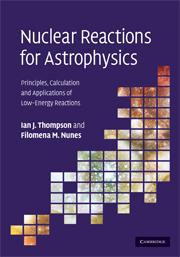Book contents
- Frontmatter
- Contents
- Preface
- Sources of quotations
- Acknowledgements
- 1 Nuclei in the Cosmos
- 2 Reactions of nuclei
- 3 Scattering theory
- 4 Reaction mechanisms
- 5 Connecting structure with reactions
- 6 Solving the equations
- 7 Approximate solutions
- 8 Breakup
- 9 Three-body nuclei
- 10 R-matrix phenomenology
- 11 Compound-nucleus averaging
- 12 Stellar reaction rates and networks
- 13 Connection to experiments
- 14 Spectroscopy
- 15 Fitting data
- Appendix A Symbols
- Appendix B Getting started with Fresco
- Select bibliography
- Index
7 - Approximate solutions
Published online by Cambridge University Press: 05 March 2012
- Frontmatter
- Contents
- Preface
- Sources of quotations
- Acknowledgements
- 1 Nuclei in the Cosmos
- 2 Reactions of nuclei
- 3 Scattering theory
- 4 Reaction mechanisms
- 5 Connecting structure with reactions
- 6 Solving the equations
- 7 Approximate solutions
- 8 Breakup
- 9 Three-body nuclei
- 10 R-matrix phenomenology
- 11 Compound-nucleus averaging
- 12 Stellar reaction rates and networks
- 13 Connection to experiments
- 14 Spectroscopy
- 15 Fitting data
- Appendix A Symbols
- Appendix B Getting started with Fresco
- Select bibliography
- Index
Summary
If you meet an operator walking down Guildford High Street, you can't tell if it is Hermitean just by looking at it. You've got to know the environment it is living in.
Ron JohnsonApproximations in physics are often very useful. In nuclear reactions in particular, depending on the specific regime, some approximations may offer a very large simplification of the problem and still provide great accuracy. Of course, to some extent, all methods in nuclear reactions are approximate, but let us consider that the solution methods discussed in Chapter 6 are the starting point to which approximations can be considered.
One idea appears when there are variables with distinct timescales, as then an adiabatic approximation can be made. Another idea is based on classical arguments. By taking a certain trajectory for the projectile, we can separate out the dynamics of the reaction and treat just what is happening to the projectile within quantum mechanics (semiclassical methods). For instance, at very high energies, the projectile's trajectory is hardly bent and the straight-line approximation is valid (called the eikonal approximation). For cases where the reaction is Coulomb dominated, taking a Rutherford trajectory for the center of mass of the projectile may be adequate, and if so provides useful simplifications of the problem. When the potential is very smooth and for slow reactions (low energies), we may make use of theWKB approximation. In this chapter we summarize the most important approximations used in reactions and discuss their limits of validity.
- Type
- Chapter
- Information
- Nuclear Reactions for AstrophysicsPrinciples, Calculation and Applications of Low-Energy Reactions, pp. 229 - 253Publisher: Cambridge University PressPrint publication year: 2009

